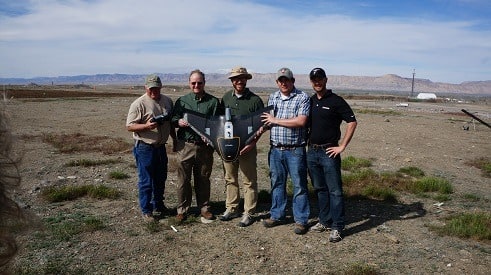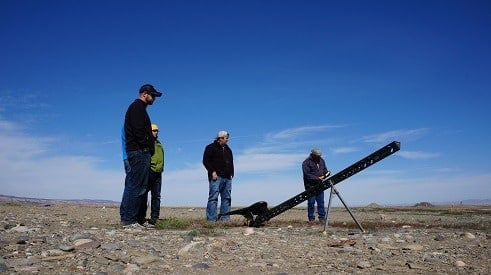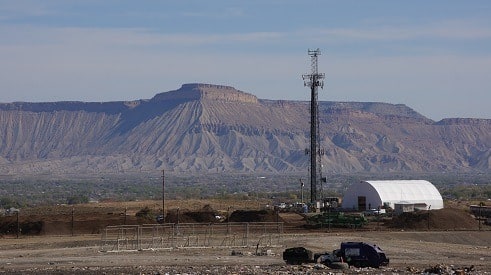UAS technology holds tremendous potential to transform industries, including waste management. Whether it is making 3-D maps of landfills or improving sorting technology, unmanned systems may become a standard tool in the waste management industry.
Michael Toscano
The innovations that have had the most profound effect on the world are the ones that change the way we use old technologies, making them more accessible, cheaper and, ultimately, indispensable. They are not standalone inventions, but the combination of several technologies or systems that build off of existing platforms. Whether it is the combination of mass production techniques with writing in the printing press, or making existing communications systems wireless via cellular phones, these technologies have a cascading effect on our societies that ultimately change the way we interact, do business and live our daily lives. Tracing the history of these innovations shows us why these technologies are important and just where waste management may be headed.
Changing Technology
Communication changed profoundly when Samuel Morse sent the first telegraph in 1844. This led to the invention of the telephone in 1876 and, eventually, the radio in the early 20th century. While each of these inventions improved lives, it wasn’t until Motorola introduced the first handheld cellular device that we saw the true potential of this technology. Since then, the technology has gotten smaller, more powerful and less expensive, helping them spread across the globe.
Now, cell phones are ubiquitous. A recent U.N. study found that 6 billion people have access to mobile phones. And this modern technology is more than just a phone. The power of mobile phones have connected people with remote parts of the world via the Internet, allowing people to do business without ever meeting each other or having even buy a computer. In Africa, more people own mobile phones than have bank accounts, making mobile banking a fast-growing industry.
A similar process happened with the production of the automobile. While the technology existed for decades, it wasn’t until Henry Ford combined it with modern manufacturing techniques to make cars affordable for the masses. This changed the culture of the U.S., as people had widespread access to transportation and the freedom to travel long distances on their own. It led to the creation of suburbs and the U.S. interstate System, one of the largest public works projects in the history of humanity.
The spread of cars, estimated at one billion in the world now, has its drawbacks as well. Traffic wastes time and fuel, costing an estimated $121 billion each year. Cars are also dangerous, causing 30,000 deaths a year. But technology is being developed that can make our roads safer and more efficient. Automating vehicles will not only reduce accidents, but also cut back on traffic, saving money and lives. Google and others are working on this technology now, and may have it ready for everyday use in the next three to seven years.
Unmanned Systems
The same technology that is powering the revolution in mobile phones and automated vehicles is also powering the unmanned systems industry. The miniaturization of cameras, allowing them to fit in cell phones means they can be carried by small aircraft, and the GPS that helps you find directions can also direct robotics remotely.
Combining these technologies allows us to do work that is difficult, dangerous or expensive more efficiently and safely. By taking the pilot out of the cockpit and putting him or her on the ground, unmanned aircraft systems (UAS) are able to fly much lower than manned aircraft, at a lower cost, and able to cover ground much faster than people can.
These qualities make UAS ideal for aerial surveys of anything from farms to wildlife to landfills. A small UAS can carry a high-definition camera over a landfill, taking high-resolution photos to accurately and precisely estimate the volume of the site. This isn’t theoretical; it’s already being done in the U.S. and around the world.
In Colorado, the Mesa County Sheriff’s Office has used UAS to survey its county’s landfill. With manned aircraft the survey cost about $10,000, and with a UAS, only $250. The county also received permission from the FAA to use a UAS to determine volumes and compaction of its county landfill. A project in Wales is also using UAS to work with construction and demolition sites to reduce waste and increase recycling. This technology is constantly improving as well. Archaeologists in Mexico are using UAS to create 3-D models of Mayan ruins using UAS, a technology that one day could be applied the waste management industry.
UAS aren’t the only unmanned systems platform that will be in the future of the waste management industry. Robotics have already begun to automate and improve waste management systems. Engineers around the world have developed new technologies that more efficiently and effectively sort waste, increasing recycling and cutting costs. Automated vehicles may also one day be a part of waste management fleets, collecting and transporting waste.
FAA Regulations
Waste management is only one of the nearly limitless applications of this technology. Industries from technology giants to Hollywood filmmakers want to use UAS as soon as possible. Unfortunately, commercial use of this technology is not yet permitted by the Federal Aviation Administration (FAA). In 2012, Congress passed and the president signed into law an act that mandated the agency with creating regulations for the safe and responsible integration of UAS into the U.S. airspace by September 2015. The process has suffered considerable delays, but a draft rule for UAS weighing less than 55 pounds is expected in November of this year.
Meanwhile, the FAA announced in May that it would begin considering exemptions for specific low-risk uses of the technology, such as precision agriculture, filmmaking and pipeline inspections. Several organizations have already put in requests for exemptions, including a coalition of film production companies, Yamaha and Amazon.com. Although there have not been any landfill exemption requests yet, it shouldn’t be considered high risk because of the simple fact that no one has thought of it yet.
The Association for Unmanned Vehicle Systems International, is working with the FAA, lawmakers and stakeholders to advocate for the safe and responsible use of UAS technology in the U.S. Despite delays, the integration process is progressing and we are getting closer to seeing widespread commercial use of this technology in the U.S.
Tremendous Potential
UAS technology holds tremendous potential to transform industries, including waste management. Whether it is making 3-D maps of landfills or improving sorting technology, someday soon, unmanned systems may become a standard tool in the waste management industry.
Michael Toscano is President and CEO of the Association for Unmanned Vehicle Systems International (AUVSI). In this role, Michael oversees all aspects of the more than 7,500 member organization as well as represents the unmanned systems industry before Congress, the media and other stakeholders. He has appeared on national news broadcasts such as the PBS Newshour and has been widely quoted in U.S. and international media including the Boston Globe, USA Today, The Washington Post, the Associated Press and CNN. Michael has also been called to testify before the U.S. Senate Judiciary Committee on issues related to unmanned systems. He can be reached at [email protected].



Photo Credits: Ben Miller
